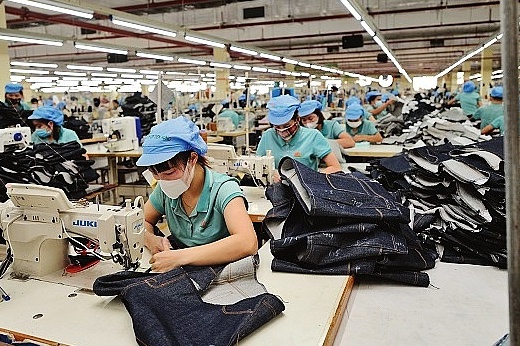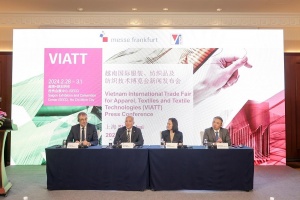Garment orders rise but costs still surge
Cao Huu Hieu, general director of Vietnam Textile and Garment Group (Vinatex), said that the garment and textile export market was thriving, and most of Vinatex’s member companies had signed orders until the end of September and October and would continue to sign orders through to the end of 2024.
 |
| There has been a general order recovery in 2024, but price stability is still an issue, as are shipping costs |
“The garment and textile export turnover in the first six months increased by 5 per cent over the same period last year, of which the bright spot for Vietnam’s garment and textile exports was in the US market, when it rose to the top of garment export market share, surpassing China,” Hieu said.
In 2024, Vinatex has targeted reaching VND18 trillion ($720 million) and $22 million in consolidated revenue and pre-tax profit, respectively, slightly increasing by 2 per compared to the previous year. In the first half of the year, the group’s revenue is estimated to be on target.
According to the General Statistics Office, the industry’s production output increased by 4 per cent in May 2024 and 5.4 per cent in the first five months of the year. After 16 consecutive months of negative growth, the employment index in the garment and textile industry began to grow again in April 2024.
Bui Van Tien, general director of Viettien General Garment JSC, said that Vietnam’s garment and textile industry had seen an order recovery from the first quarter of 2024 and improved orders in May and June.
However, Tien warned that, “orders have improved, but the price level is still not stable, while currently, the pressure on shipping costs is even greater due to tensions in the Red Sea, causing business profits to shrink.”
Local businesses are facing competition on price, which has not improved over the past two years according to Vinatex.
Nguyen Hong Lien, deputy general director of Hue Textile and Garment JSC, said that although customers had made many transactions for the third quarter and some had even implemented programmes for the fourth quarter, they were still short of the forecast level.
The most difficult aspect of the market today is that delivery time is short, but the number and size of orders is increasing. If in 2023 the order size was small and diverse, by 2024 the orders have a scale of hundreds of thousands, and even over one million products, but the delivery time is very short.
“To comment on the market in the last six months of the year, almost all customers agree that it is difficult to give specific numbers like the first half of the year. Therefore, businesses also need to build new scenarios to help stabilise production management if the market suddenly reverses compared to the first half of 2024,” Lien said.
Meanwhile, the Vietnam Textile and Apparel Association said the industry is facing many risks in the supply chain. Businesses have had to increase investment to meet the requirements of brands on greening, extended producer responsibility, environmental, social, and governance, and digital transformation.
According to the association, the Vietnamese garment and textile industry in 2024 is projected to recover slowly. This is mainly attributed to declining demand in the international market. The industry’s target is to export goods worth $44 billion this year, which is quite challenging.
 | 70,000 garment and textiles job cuts since January According to a report of the Ministry of Labour, Invalids and Social Affairs (MoLISA) released on June 5, workers in the garment and textile sector suffered the most from a series of job cuts in the first five months of this year, with 70,000 workers losing their jobs and 66,600 having their working hours reduced. |
 | Vietnam's garment and textile companies eye sustainable products Companies seek to diversify supply chains to tap into opportunities from a wide range of new-generation free trade agreements and an increasing flow of investments into the local market. |
 | Quality Vietnamese apparel still favoured abroad Vietnam’s biggest apparel association has denied that the garment and textile industry is losing its competitive advantage in the United States. |
What the stars mean:
★ Poor ★ ★ Promising ★★★ Good ★★★★ Very good ★★★★★ Exceptional
Related Contents
Latest News
More News
- Businesses ramp up production as year-end orders surge (December 30, 2025 | 10:05)
- Vietjet chairwoman awarded Labour Hero title (December 29, 2025 | 13:06)
- How to unlock ESG value through green innovation (December 29, 2025 | 10:03)
- AI reshapes media and advertising industry (December 29, 2025 | 08:33)
- FPT and GELEX sign deal to develop blockchain tech for global markets (December 29, 2025 | 08:29)
- Vietnam’s GDP forecast to grow by 9 per cent in 2026 (December 29, 2025 | 08:29)
- Women entrepreneurs are key to Vietnam’s economic growth (December 29, 2025 | 08:00)
- Vietnam's top 500 value-creating enterprises announced (December 27, 2025 | 08:00)
- The PAN Group shaping a better future with ESG strategy (December 26, 2025 | 09:00)
- Masan Consumer officially lists on HSX, marking the next phase of value creation (December 25, 2025 | 13:20)

 Tag:
Tag:





















 Mobile Version
Mobile Version